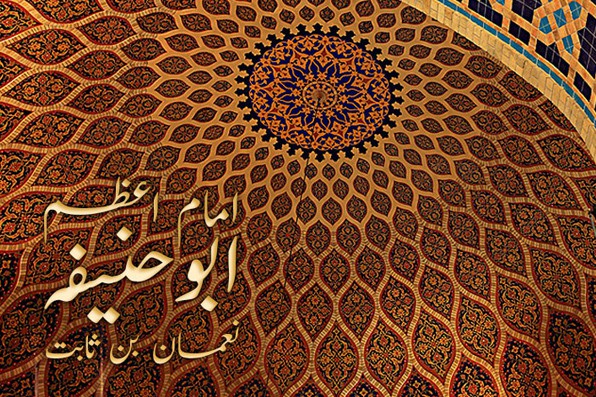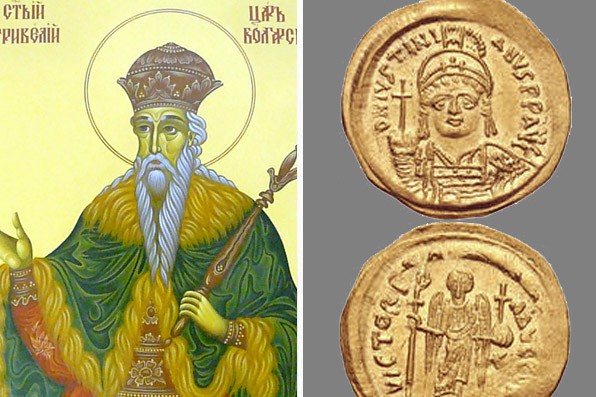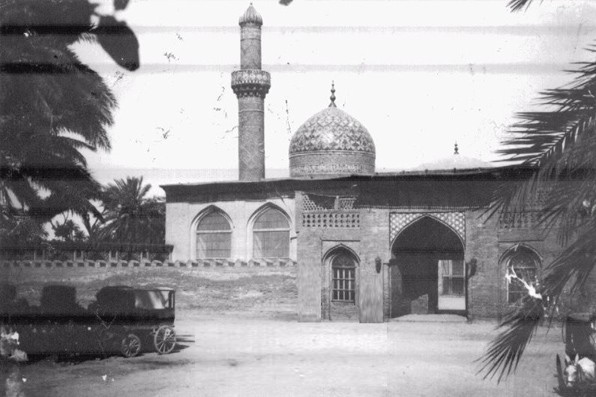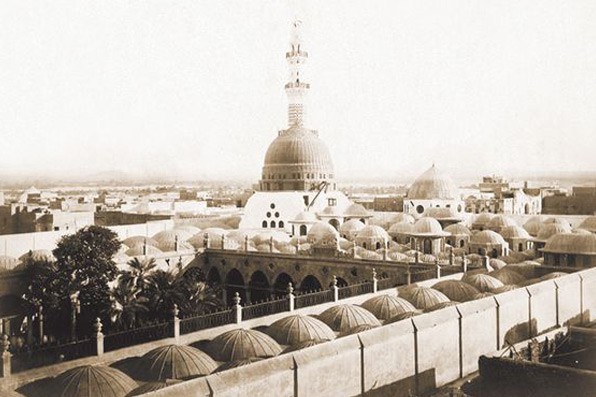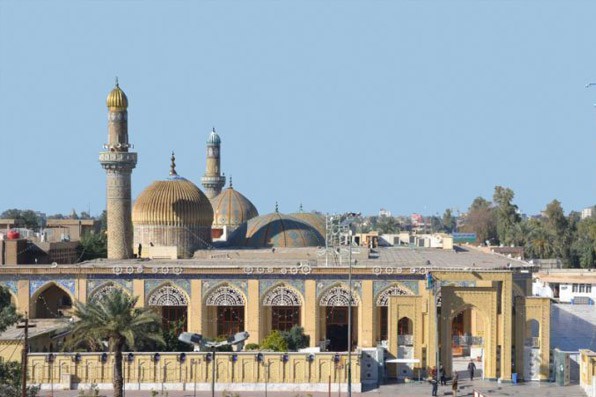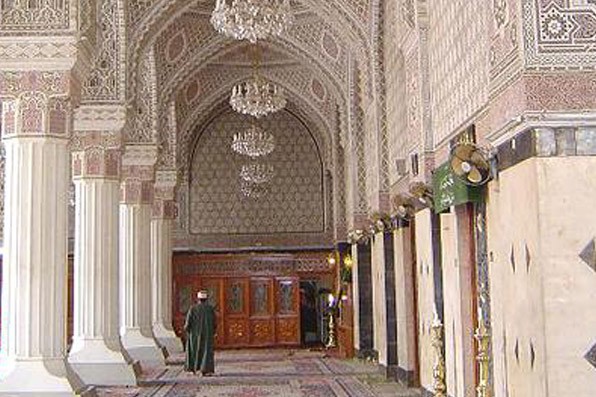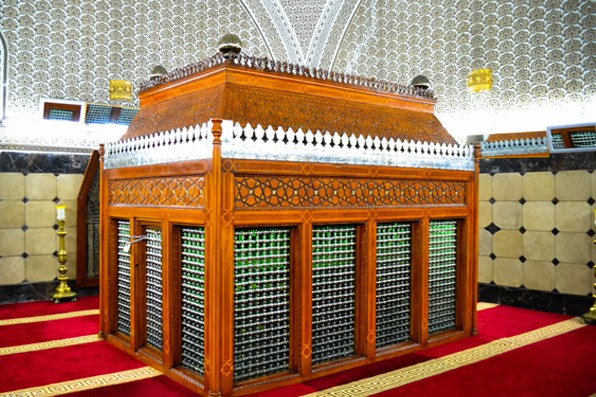Imam Abu Hanifa RA – URS 2nd Shaban
Imam Abu Hanifa RA – URS 2nd Shaban
Imam Abu Hanifa RA – URS 2nd Shaban.
In a delightful report about how Imam Abu Hanifa (RA) received his name (his original name is Numan bin Thabit bin Zuta bin Mah), an account of why the wife is forbidden to take more than one husband is recounted. ‘Abu Hanifa RA’ is an unusual name because it means ‘the father of Hanifa’, and Hanifa was his daughter. Normally, the name would be ‘the father of the name of a son.’ How this came about is surprising and unexpected.
One day Imam Abu Hanifa (RA) was asked a question that, for the first time in his illustrious career, he was unable to answer. The question was, “Why were women forbidden to marry more than one husband at a time?”
To shorten the story, Abu Hanifa’s (RA) daughter said that she knew the answer and would solve this question if her father would make a promise to her that if she succeeded in solving this problem, he would then assure her a place in history. Abu Hanifa RA agreed.
So she gathered a group of women together and gave each of them a cup. Then she brought in a large bowl of milk and asked each of them to dip their cups in the milk and to fill their cups. They did so. She then asked them to pour back the milk into the bowl. They did this too. She then asked them to re-fill their cups taking back only their own milk that they had poured into the bowl.
This, obviously, was impossible to do. Imam Abu Hanifa (RA) had clearly demonstrated the kind of predicament that would be created if a woman had several husbands. With more than one husband, if she were to become pregnant, she would have exceptional difficulties determining who the actual father was? Identifying parentage and lineage would then be insurmountable for the offspring. Imam Abu Hanifa was so pleased with her answer that he took the name ‘Abu Hanifa’, ‘the father of Hanifah’, so his daughter did indeed earn a place in history.
=======
Imam Suyuti (911) (Rahimahullah) mentions that Imam Tabari (478) (Rahimahullah) has a written a few ahadith from Imam Abu Hanifa (Rahimahullah) which proves that he actually met the following Sahaba: Anus bin Malik RA, Jabir bin Abdullah RA, Abdullah bin Jaza al Zubaydi RA, Maqal bin Yasaar RA, Wathila bin al Asqa RA and Aisha bint Ujrah (Radiallahu Taala Anhum Ajmaeen)
It is mentioned in the hadith:
عن أبي هريرة، قال: قال رسول الله صلى الله عليه وسلم: لو كان الدين عند الثريا، لذهب به رجل من فارس – أو قال – من أبناء فارس حتى يتناوله()
Abu Hurairah (Radiyallahu Anhu) narrates that Rasulullah Salallahu Alayhi Wasallam said: If Deen was suspended from Pleiades and the Arabs are unable to reach it, then a man from the sons of Persia will be able to reach it. (Muslim-2546 Darul Fawaid)
=======
The Atheists
It has been reported from Imam Abu Hanifa that he said he was like a sword on the atheists of his time. There were many of them and they had power and strength and were always looking for an opportunity to kill him. One day whilst he was sitting alone in the mosque, a group of them pounced on him with knives and swords drawn and were just about to kill him when he said to them, “Take it easy just answer one question then you can do what you please.”. they agreed. He asked, “What do you say regarding a man who says I saw a ship, a vessel loaded with cargo, full with goods, in the depths of some ocean, being battered by gales and rough waves without a navigator, or anybody to care of it. Despite this it proceeds taking its course. Is something like this possible even in the mind?” They replied “No, this is a thing that one’s mind doesn’t accept and one’s imagination doesn’t permit.” Imam Abu Hanifa said, “Subhanallah, if it is not possible in the mind for a ship to keep its course in these conditions without a navigator or a crew, then how is it possible for this world to carry on despite its ever fluctuating conditions and constantly changing affairs and activities without a creator or a care taker.” They all began to cry and said, “You are right.” They put away their swords and repented from their sins and error.
=======
A Wise Young Muslim Boy
Many years ago, during the time of the Tabi’in RA (the generation of Muslims after the Sahabah RA), Baghdad was a great city of Islam. In fact, it was the capital of the Islamic Empire and, because of the great number of scholars who lived there, it was the center of Islamic knowledge.
One day, the ruler of Rome at the time, probably Bulgarian Ruler Tervel after defeating Ceasar Justin, sent an envoy to Baghdad with three challenges for the Muslims. When the messenger reached the city, he informed the khalîfah that he had three questions which he challenged the Muslims to answer.
The Khalifah gathered together all the scholars of the city and the Roman messenger climbed upon a high platform and said, “I have come with three questions.
If you answer them, then I will leave with you a great amount of wealth which I have brought from the king of Rome.” As for the questions, they were: “What was there before Allah?” “In which direction does Allah face?” “What is Allah engaged in at this moment?”
The great assembly of people were silent. (Can you think of answers to these questions?) In the midst of these brilliant scholars and students of Islam was a man looking on with his young son. “O my dear father! I will answer him and silence him!” said the youth. So the boy sought the permission of the Khalifah to give the answers and he was given the permission to do so.
The Roman addressed the young Muslim and repeated his first question, “What was there before Allah?”
The boy asked, “Do you know how to count?”
“Yes,” said the man.
“Then count down from ten!” So the Roman counted down, “ten, nine, eight, …” until he reached “one” and he stopped counting
“But what comes before ‘one’?” asked the boy.
“There is nothing before one- that is it!” said the man.
“Well then, if there obviously is nothing before the arithmetic ‘one’, then how do you expect that there should be anything before the ‘One’ who is Absolute Truth, All-Eternal, Everlasting the First, the Last, the Manifest, the Hidden?”
Now the man was surprised by this direct answer which he could not dispute. So he asked, “Then tell me, in which direction is Allah facing?”
“Bring a candle and light it,” said the boy, “and tell me in which direction the flame is facing.”
“But the flame is just light- it spreads in each of the four directions,
North, South, East and West. It does not face any one direction only,” said the man in wonderment.
The boy cried, “Then if this physical light spreads in all four directions such that you cannot tell me which way it faces, then what do you expect of the Nûr-us-Samâwâti-wal-‘Ard: Allah – the Light of the Heavens and the Earth!? Light upon Light, Allâh faces all directions at all times.”
The Roman was stupified and astounded that here was a young child answering his challenges in such a way that he could not argue against the proofs. So, he desperately wanted to try his final question. But before doing so, the boy said,
“Wait! You are the one who is asking the questions and I am the one who is giving the answer to these challenges. It is only fair that you should come down to where I am standing and that I should go up where you are right now, in order that the answers may be heard as clearly as the questions.”
This seemed reasonable to the Roman, so he came down from where he was standing and the boy ascended the platform. Then the man repeated his final challenge, “Tell me, what is Allah doing at this moment?”
The boy proudly answered, “At this moment, when Allah found upon this high platform a liar and mocker of Islam, He caused him to descend and brought him low. And as for the one who believed in the Oneness of Allah, He raised him up and established the Truth. Every day He exercises (universal) power (Surah 55 ar-Rahman, Verse 29).”
The Roman had nothing to say except to leave and return back to his country, defeated. Meanwhile, this young boy grew up to become one of the most famous scholars of Islam. Allah, the Exalted, blessed him with special wisdom and knowledge of the deen. His name was Abu Hanifa (Rahmatullah Alayhi- Allah have mercy on him) and he is known today as Imam-e-A’zam, the Great Imam and scholar of Islam.
[Adapted into English from “Manâqib Abî Hanîfah” written by Imâm Muwaffaq Ibn Ahmad al-Makki (d. 568 Hijri). Dar al – Kitâb al-‘Arabiy, Beirut, 1981/1401H.]
source:[Adapted into English from “Manâqib Abî Hanîfah” written by Imâm Muwaffaq Ibn Ahmad al-Makki (d. 568 Hijri). Dar al – Kitâb al-‘Arabiy, Beirut, 1981/1401H.]
=======
The Greatest Imam, Abu Hanifa RA
By Dr. G.F. Haddad
Al-Nu`man ibn Thabit al-Taymi, al-Imam Abu Hanifa (d. 150AH), called “The Imam” by Abu Dawud, and “The Imam, one of those who have reached the sky” by Ibn Hajar, he is known in the Islamic world as “The Greatest Imam” (al-Imam al-Azam) and his school has the largest number of followers among the four schools of Ahl al-Sunna.
He is the first of the four Mujtahid Imams and the only Successor (Tabi`in RA -Successors of the Sahaba RA) among them, having seen the Companions Anas ibn Malik RA, Abd Allah ibn Abi Awfa RA, Sahl ibn Sad al-Saidi RA, Abu al-Tufayl RA, and Amir ibn Wathila RA.
Imam Abu Hanifa (RA) is the first in Islam to organize the writing of fiqh under sub-headings embracing the whole of the Law, beginning with purity (Tahara) followed by prayer (Salaah), an order which was retained by all subsequent scholars such as Malik RA, Shafi`i RA, Abu Dawud RA, Bukhari RA, Muslim RA, Tirmidhi RA and others. All these and their followers are indebted to him and give him a share of their reward because he was the first to open that road for them, according to the Hadith of the Prophet: “He who starts something good in Islam has its reward and the reward of those who practice it until the Day of Judgement, without lessening in the least the reward of those who practice it. The one who starts something bad in Islam will incur its punishment and the punishment of all those who practice it until the Day of Judgement without lessening their punishment in the least.” Al-Shafi`i RA referred to this when he said: “People are all the children of Abu Hanifa RA in fiqh, of Ibn Ishaq in history, of Malik in Hadith, and of Muqatil in Tafsir.”
Source:By Dr. G.F. Haddad
=======
Imam Abu Ḥanifa RA, (699 — 767 CE / 80 — 148 AH-150AH) was the founder of the Sunni Hanafi school of fiqh (Islamic jurisprudence).
Al Imam al A’zam (the Great Imam), as he is referred to by those who adore him, was the first to define the processes that govern Usool e Fiqh (the principles of Fiqh). He preceded Imam Malik RA by ten years, Imam Shafii RA by a generation and Imam Ahmed RA by a 100 years. Imam Abu Hanifa RA studied with Imam Ja’afar as Sadiq RA. In turn, the other great Imams had the benefit of the legacy of Imam Abu Hanifa RA when they took on the monumental task of codifying Fiqh.
Name, Origin & Meeting with Sahabas RA
Imām Abu Ḥanifa was born in the city of Kufa in Iraq, during the reign of the powerful Umayyad caliph Abd al-Malik ibn Marwan. His father, Thabit bin Zuta, a trader from Kabul, Afghanistan, was 40 years old at the time of Abu Ḥanifa’s birth. His ancestry is generally accepted as being of non-Arab origin as suggested by the etymology of the names of his grandfather (Zuta) and great-grandfather (Mah). The historian, Al-Khatib al-Baghdadi, records a statement from Imām Abū Ḥanīfah’s grandson, Ismail bin Hammad, who gave Abū Ḥanīfah’s lineage as Thabit bin Numan bin Marzban and claiming to be of Persian origin.
Imam Abu Ḥanifa RA was born 67 years after the death of Holy Prophet Muhammad (SWS), but during the time of the Sahaba of Holy Prophet Muhammad (SWS), some of whom lived on until Abu Ḥanifa’s youth. Anas bin Malik RA, Holy Prophet Muhammad’s (SWS) personal attendant, died in 93 AH and another companion, Abul Tufail Amir bin Wathilah RA, died in 100 AH, when Abu Ḥanifah RA was 20 years old.
However, the author of al-Khairat al-Hisan collected information from books of biographies and cited the names of the Sahaba RA whom it is reported that the Imam has transmitted Hadith from. He counted them as sixteen of the Sahaba RA. They are: Anas ibn Malik, Abdullah ibn Anis al-Juhani RA, Abdullah ibn al-Harith ibn Juz’ al-Zabidi RA, Jabir ibn Abdullah RA, Abdullah ibn Abi Awfa RA, Wa’ila ibn al-Asqa RA, Ma`qal ibn Yasar RA, Abu Tufail Amir ibn Wa’ila RA, A’isha bint Hajrad RA, Sahl ibn Sa`d RA, al-Tha’ib ibn Khallad ibn Suwaid RA, al-Tha’ib ibn Yazid ibn Sa`id RA, Abdullah ibn Samra RA, Mahmud ibn al-Rabi RA, Abdullah ibn Ja`far RA and Abu Umama RA (Radiallahu Taala Anhum Ajmaeen).
Early Life of Imam Abu Hanifa RA
Nu’man bin Thabit RA, later known by his universal name Imam Abu Hanifa RA, was born in the year 699 CE in the city of Kufa. As it is with most famous men and women in history, his lineage is claimed by Iranians, Afghans and Arabs alike. But most scholars agree he was of Afghan parentage through his grandfather Marzuban. Kufa was at the time a garrison city in a period of rapid expansion of the Omayyad Empire. It was also the provincial capital of Iraq and a commercial center, a meeting place for Persians, Arabs, Afghans and Indians. Turkish tribesmen wandered in from Central Asia as did the Chinese from far away Sinkiang. Abu Hanifa RA was only twelve years old when Sindh and Multan were added to the Omayyad domains through the conquests of Mohammed bin Qasim (711CE).
The melting pot that was Kufa left a lasting impact on the young Abu Hanifa RA and this impact is reflected in his Fiqh. His oft-quoted saying: “The Iman (faith) of a converted Turk is the equal of the Iman of a resident of Medina”, summarizes his openness and acceptance of people of all nations and ethnic origins.
Kufa was a very different town from Medina. While Medina was the city of the Holy Prophet (SWS), the cradle of Islamic civilization, insulated from the convulsive currents in faraway lands, Kufa was at the very center of cultural and intellectual turbulence brought on by the mixing of Persian Zoroastrians, Chinese Buddhists, Indian Hindus, Roman Christians and Arab Muslims. The geopolitical as well the cultural contexts of the two cities was different. This background must be kept in mind by students of comparative Fiqh who study the positions of the various schools of Fiqh on specific issues.
Abu Hanifa RA, born as he was into a merchant family, learned the silk trade from his grandfather. His early training was in commerce rather than in Sunnah and Fiqh. It is related that when he was eight years old and was on his way to his grandfather’s silk store, he was stopped by a Shaykh and was asked which madrasa he was headed to. The Shaykh saw the light on the face of the young Abu Hanifa RA and sensed his great potential. When Abu Hanifa RA answered that he was headed to the silk store of his grandfather and not to a madrasa, the Shaykh guided him instead to a classroom. The young Abu Hanifa RA made rapid progress and soon outperformed all the other students in his class, memorizing the Quran, learning Hadith and Sunnah and soaking in the knowledge that the best of the Shaykhs had to offer.
The learning of the young Shaykh Abu Hanifa RA soon attracted the attention of students and scholars. Young and old alike attended his halqa (a circle of students) and learned from him. Traveling to the Hijaz, Abu Hanifa RA performed his Hajj and spent two years in Medina attending the halqa of Imam Ja’afar as Sadiq RA, learning from him the inner meaning of the Shari’ah as transmitted from the Holy Prophet (SWS) through ahl-e-bait. There is, however, another tradition which believes that Imam Abu Hanifa RA and Imam Ja’afar as Sadiq RA never met. However, on the basis of the well known saying of Imam Abu Hanifa RA, “If it were not for the two years I spent with Ja’afar as Sadiq RA, I would be left wandering”, we accept the premise that Imam Abu Hanifa RA did indeed attend the halqa of Imam Ja’afar as Sadiq RA and learned ilm ul-ishara (the knowledge of the unseen) from him.
Imam Abu Hanifa RA had a unique method of teaching his students. Instead of giving them solutions to specific questions brought before him, the Imam would divide up his students into two groups. One group was asked to defend a proposition while the other was asked to oppose it. “What if” propositions were placed before the class. The students would study the Quran, the Sunnah, the hadith as well as the earlier decisions taken by the Suhaba, passionately debate among themselves, and would finally come up with a consensus. The process was devised to remove any probability of error in the judgment and the premise was that a higher truth emerges out of the dialectic (debate) of two opposing positions. A thousand years later, the same process became the foundation for the Hegelian dialectic, a school of philosophy named after the German philosopher George Wilhelm Frederich Hegel (1770-1831). Hegel is considered the father of dialectic philosophy. The Marxists as well as the German nationalists before the Second World War considered Hegel to be the father of their ideology.
Imam Abu Hanifa RA was keenly aware of the challenges faced by jurists in the dynamic social environment of Kufa. The Zoroastrians, the Buddhists, the Hindus, the Muslims, the Sabians and the Christians had their own view of the cosmos and their own way of relating to the transcendent. As more and more followers of these ancient faiths accepted Islam, especially during the reign of the Caliph Omar bin Abdel Aziz (717-719 CE), there arose the immediate challenge of answering the questions posed by the new entrants to the Islamic faith. Imam Abu Hanifa RA rose to the challenge. He looked upon Fiqh as a dynamic process, applicable in all ages and all locations. No jurist of the future would be left without the tools required to search for solutions to the specific issues faced by him in his own space and time.
ACQUIRING OF KNOWLEDGE
Imam Abu Hanifa RA attended the lectures of Sayyiduna Hammad Basri (Radi Allah Anhu) in Fiqh and then began to study the Hadith. He learnt under great scholars in Kufa. In Basrah he studied under two great Taabi’in scholars who had learnt Hadith under the Sahaba RA. In Makkatul Mukarammah and Medinatul Munawwarah, he learnt under Sayyiduna Ata bin Abi Rabah and Sayyiduna Ikramah (Radi Allahu Anhuma). In fact, Imam A’zam Abu Hanifa (RA) had numerous teachers. Some historians say that he learnt Hadith from about 4000 scholars. Some of his famous teachers were:
Sayyiduna Imam Baaqir RA
Sayyiduna Imam Jafar Saadiq RA
Sayyiduna Ali RA
Sayyiduna Abu Hurayrah RA
Sayyiduna Abdullah ibn Mas’ud RA
Sayyiduna Abdullah ibn Umar RA
Sayyiduna Aqabah bin Umar RA
Sayyiduna Safwaan RA
Sayyiduna Jabir RA
Sayyiduna Abu Qatadah and etc. (Radi Allahu Anhum Ajma’een).
Imam Abu Hanifa RA obtained Hadith from many persons travelling extensively. Abu Hatim Razi’s son heard his father say, that he kept count of the distance he covered on foot during his knowledge journey. It crossed a thousand farsakh (one farsakh = 5 km) in the first seven years, after which he stopped counting. There were innumerable times when he walked between Kufa and Baghdad and between Makkah and Medina. Once he walked from Morocco to Egypt and then continued walking visiting many cities in Palestine, then to Damascus, and then to Antioch in Turkey. He returned walking to Homs in Syria to obtain one Hadith narrated by Abu al-Yaman before boarding a boat in the Euphrates River to return to Baghdad. (Safahat min Sabr al-`Ulama, `Abdul Fattah, Abu Ghuddah).
Altogether, Abu al-Muhasin has named 319 scholars from whom Abu Hanifa RA received lessons. Sha`bi, Salama ibn Kuhayl, Abu Is-haq al-Suba`ee, Muharib ibn Wartha, `Awn ibn `Abdullah, Hisham ibn `Urwah, A`mash, Qatadah, Sho`ba, `Asim ibn Sulayman al-Ahwal, were some of the outstanding scholars of those times spread over Kufa, Basra, Makkah and Madinah whose circles Abu Hanifa RA attended.
The consequence of ambitious interest, keen intellect, studentship of renowned scholars, training in the application of reason, logic and analogy, with no financial restraints for traveling around, which exposed him to different milieus and cultures, was that Imam Abu Hanifa RA emerged as a matchless Faqeeh that ever appeared in the Islamic world. Once, someone visited Imam Malik RA. He received him with great respect. When he was gone, he asked his students, “Do you know who this was? It was Abu Hanifa RA. By Allah, if he wished, he could prove that this pillar is made of gold.”
It is narrated that Muhammad al-Baqir RA told Abu Hanifa RA during their first meeting in Medinah, “You have altered the religion of my ancestor (Holy Prophet Muhammad SWS) and (the meaning of) his traditions through (the application of) analogy.” Abu Hanifa RA said, “Allah’s refuge.” Muhammad said, “For sure, you did it.” So Abu Hanifa RA said, “Sit down in your place, as it deserves you, so that I can sit as it deserves of me to sit, for, you deserved from me as honored position as your ancestor – Allah’s peace be on him – as it was during his life over his Companions.”
So he sat down. Abu Hanifa RA genuflected before him and said, “I’ll place before you three points, reply to me: Is man weaker or woman?” Al-Baqir RA replied, “Woman.” Abu Hanifa RA said, “What is a woman’s share (in inheritance).” He said, “To a man two, while to a woman one.” Abu Hanifa RA said, “This is the saying of your ancestor (Holy Prophet Muhammad SWS). Now, had I altered his religion, then analogy should have ruled that a man should have one share while a woman two, since a woman is weaker than man.” Then he asked, “Is Prayer superior or fasts?” He said, “Prayer is superior.” He said, “This is the saying of your ancestor.”
“Had I altered your ancestor’s rulings, analogy would have said that when a woman comes out of her menstrual cycle, I should rule that she repeats the Prayers but not the fasts.” Then he asked, “Which is more unclean? Urine or sperm?” He (al-Baqir RA) said, “Urine is more unclean.” Abu Hanifa RA said, “Had I altered the religion of your ancestor through analogy, I should have ruled that (when dirtied by) urine (one may) wash himself but make ablution (when dirtied by the emission of) the sperm. But, Allah’s refuge that I should alter the religion of your ancestor through analogy.” Muhammad Al-Baqir RA stood up, hugged him, kissed his face, and paid him his respects.
CHARACTER & PERSONALITY OF IMAM ABU HANIFA RA
Imam A’zam Abu Hanifa (RA) earned his living by trading. Every Friday, he distributed 20 gold coins to the poor for his parents soul. For 40 years Imam A’zam Abu Hanifa (RA) performed the Fajr Salaah with the Wudu that he made for the Isha Salaah (ie. he did not sleep after the night prayer). He performed Hajj 55 times. He used to recite the entire Holy Quran once every day and once every night. Imam A’zam Abu Hanifa (RA) had so much of Taqwa (Piety) that for 30 years he fasted every day (except for the 5 forbidden days). He often read the Holy Quran in one rakaah or two. He wore clothes like those of the poor. Imam A’zam Abu Hanifa (RA) once said: “I laughed once in my life and I regret it.” He talked little and thought much. It is said that at the place where his soul was taken, he read the Holy Quran 7000 times.
FIQH
Fiqh is the historical dimension of the Shari’ah. It is the human attempt to apply the Shari’ah so that they discharge the Divine commandment to create Divine patterns on earth. It defines the how, what, who when and what ifs of the Shari’ah. The process of Fiqh is a dynamic balance between the application of Divine Mercy and Divine Wrath with justice acting as the governing principle. The Quran and the hadith explain clearly that Divine Mercy is preponderant over Divine wrath (The Quran, 11:119. Please also see the hadith, “By Him in whose Hand is my life, if you were not to commit sin, Allah would sweep you out of existence, and He would replace you by those people who would commit sin and seek forgiveness from Allah, and He would have pardoned them.“ Sahih Muslim, Volume 4, 1143, Kitab al-Tauba). The majestic panorama of creation revolves around knowledge, worship, service and forgiveness. The dimensions of Shari’ah are infinite. The dimensions of Fiqh are finite and it has definite hudood (limits).
HANIFI FIQH
The Hanafi Fiqh which evolved as an outgrowth of the teachings of Imam Abu Hanifa RA offers five sources for the development of Fiqh: the Quran, the Sunnah of the Holy Prophet (SWS) and his confirmed Ahadith, the Ijmah of the Companions, Qiyas and Estehsan. The different schools of Fiqh differ on the importance of these five sources. The Maliki school which grew up in Madina in the heart of the Islamic world, accepts the Quran, the Sunnah of the Holy Prophet (SWS) and the collective Ijmah of all the Companions as sources of Fiqh but it rejects Qiyas and Estehsan. The Shafii school requires the Ijmah of the Companions to be universal as does the Maliki Fiqh, but unlike the Maliki Fiqh, it accepts the principle of Qiyas under exceptional circumstances. The Shafii Fiqh rejects Estehsan as does the Ithna Ashari Fiqh. The Hanbali Fiqh is the strictest of them all. It accepts only the Quran, the verified Sunnah of the Holy Prophet (SWS) and the universal consensus of the Companions as sources of Fiqh.
The Sunnah schools accept the mutuality of the four major schools of Fiqh, namely, Hanafi, Maliki, Shafii and Hanbali (RA). They differ only in their emphasis of the sources of Fiqh.
It was the genius of Imam Abu Hanifa RA that he left behind a legacy of jurisprudence, and the broadest principles that practically any jurist at any time and any place could use. Al Madhab al Qiyas, for instance, is the science of analogy. Qiyas literally means to measure, to place something in balance. Where a direct injunction from the Quran and the Sunnah of the Holy Prophet (SWS) is not available, the principle of Qiyas permits a jurist to use the force of analogy, to measure the preponderance of evidence and offer a legal opinion on a juridical matter. Similarly, where an entirely new situation arises which was not foreseen in earlier times, the principle of Estehsan provides a jurist the independence of Ijtihad (which means a rigorous intellectual exercise to arrive at a legal opinion).
Imam Abu Hanifa RA was a successful merchant and in his Mu’amilaat (commercial transactions) demonstrated a fastidious adherence to the principles of the Shari’ah. It is related that once the Imam gave a loan to a man to build a house. The next year, on a hot summer day, as the Imam was walking through the streets of Kufa, he felt tired and paused briefly in the shade of a house. When he enquired whose house it was, he was told that the house belonged to the man whom the Imam had given the loan. The Imam was terrified that he had taken an Idhafa (an increase) in the loan by taking advantage of the shade of the house and on the Judgment Day he would have to answer for his deeds because the act of taking refuge in the shade of a house for which he had given a loan might be construed as riba. Distraught, Imam Abu Hanifa RA forgave the loan.
Even while maintaining the rigor of his principles, al Imam al A’zam, Abu Hanifa RA was very human and had a keen sense of humor. Once a man asked him about taking a swim in the river. “Should I face the qibla when I bathe in the river”, asked the man. “No”, replied the Imam, “You should face the bank of the river and watch your clothes”.
Death of Abu Hanifa RA
Later in 146H, when Ibrahim ibn Hasan RA (a descendant of Hazret Ali RA) rebelled against the Abbasids, Imam Abu Hanifa RA supported his cause and helped him with a big sum. Earlier, when Zayd RA, the son of Zayn al-`Aabideen RA rose against the Umayyad’s, Abu Hanifah RA had helped him too. He believed that the Alawiyyun deserved Khilafah more than the Umayyads or Abbasids. When Mansur, the Abbasid Caliph, came to know of his inclination towards the progeny of Sayyidina Ali RA, he invited him to settle down in Baghdad and take up the post of Chief Justice. Abu Hanifah RA refused. Several meetings took place to persuade Abu Hanifa RA.
On one occasion, Mansur said, “By Allah, you will have to accept the job” The Imam replied, “By Allah, I will not.” Mansur was boiling with anger. He said, “Do you swear upon my oath?” He replied, “Yes, because it is easy for you to break your oath and offer expiation than me.” At one point Abu Hanifah RA told him that he did not think he was fit for the job Mansur said, “Of course, you are! You are lying.” Abu Hanifa RA said, “If I am lying, then I am disqualified for the judiciary.” Ultimately, he got him imprisoned. The Imam kept conducting classes from the prison. Mansur did not feel safe from him and his powerful political influence, even when behind the bars.
His success and his greatness made the political establishment of the times jealous of him. In 766 CE Caliph al Mansur asked Imam Abu Hanifa RA to be the chief Kadi (judge) of Baghdad. The Caliph had hoped that by offering him a high post he could bring the Imam under his control. But the great ulema and sages and awliyah have through the ages refused the favors of kings and noblemen to maintain their independence. Abu Hanifa RA declined. The Caliph, furious that his invitation was spurned, had the Imam flogged and put in jail.
Imam A’zam Abu Hanifa (RA) passed away while in Salaah. One account said he died because of the punishment given to by lashing and another say he had been poisoned by the orders of Caliph Mansur.
His Janaza Salaah was performed six times and each time 50,000 people took part. People continued to come and pray for him for 20 days after he was buried. He was 70 years old. In 459 A.H. a Mazaar (Tomb) was built for him by the Seljuki ruler Alp Arsalan. He lies buried in a Tomb situated near Baghdad in Iraq.
The tribute to this giant among scholars is that a large majority of Muslims around the world, from Istanbul to Dhaka, from Samarqand to Cairo, use the Fiqh named after him. The principles of Qiyas and Estehsan evolved by Imam Abu Haneefa, when they are applied in conjunction with the Quran, the Sunnah and Ijmah, provide the intellectual tools that can be used to develop a minority Fiqh (al Fiqh al Akhliyya) which has yet to emerge in the Islamic world despite the fact that more than three hundred million Muslims live as religious minorities in India, China, Russia, South Africa, Europe, Australia and North America.
STUDENTS
Imam A’zam Abu Hanifa (RA) left behind about 980 students. The most famous among them being:
a. Sayyiduna Qadi Abu Yusuf (Alaihir Rahmah)
b. Sayyiduna Imam Muhammed (Alaihir Ramah)
c. Sayyiduna Imam Zufur (Alaihir Rahmah)
WORKS by Abu Hanifa RA
Kitaab-ul-Aathaar narrated by Imaam Muhammad al-Shaybani – compiled from a total of 70,000 hadith, Kitabul Aathaar narrated by Imaam Abu Yusuf, Aalim wa’l-muta‘allim, Fiqh al-Akbar Musnad Imaam ul A’zam, Kitaabul Rad alal Qaadiriyah.
Bir hurmati Habib bir hurmati Anzalta Surat al-Fatiha.

